Artificial intelligence has come a long way, and with developments like ChatGPT, powerful language models are now more accessible than ever. ChatGPT has a lot to offer, whether you're a writer hoping to better your abilities, a researcher searching for inspiration, or intrigued about the potential of AI.
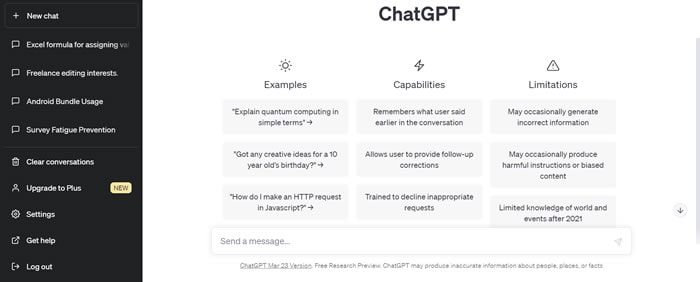
ChatGPT is an OpenAI-trained big language model built on the GPT-3.5 architecture. It is a powerful tool that can revolutionize the way you approach problem-solving, from creating new writing prompts to tackling complex research queries. In this article, we will discuss what is ChatGPT and how you can use it to boost your productivity.
Why Is There a Constant Hype About ChatGPT?
ChatGPT generates a lot of hype since it represents a substantial advancement in natural language processing (NLP). It has been trained on a large corpus of text data and can produce natural language replies to various inquiries and jobs.
The potential of ChatGPT to create natural language replies has far-reaching ramifications in a wide range of sectors, including customer service, content production, and language translation. It may assist organizations in automating everyday operations such as reporting or responding to customer inquiries, personalizing content, and improving consumer interaction.
ChatGPT's capacity to create natural language replies has piqued the interest of developers and researchers, in addition to its practical uses. It is a significant advancement in artificial intelligence and can potentially change how humans interact with robots and computers.
Filmora now offers a ChatGPT plug-in to provide a more inspirational copywriting experience.

How Does ChatGPT Actually Work?
ChatGPT can understand and produce text that sounds like human speech. It uses a deep learning approach known as transformer architecture, which enables it to analyze massive volumes of data and understand natural language patterns.
ChatGPT is trained by giving it vast volumes of text from various sources, including books, journals, and websites. It enables the model to learn how language is used in various circumstances and to develop a thorough knowledge of grammar, vocabulary, and syntax.
Once trained, ChatGPT may create text responding to a specific prompt or input. It analyzes the incoming text, identifies essential ideas and concepts, and generates new material compatible with them. The output text is frequently fluid and might be difficult to discern from human-written content.
ChatGPT's capacity to create coherent and contextually suitable language is one of its primary capabilities. It's adaptable and may be tailored to tasks or areas like chatbot development or content generation.
10 Best Ways to Use ChatGPT
ChatGPT is a robust language model that may be utilized for numerous purposes, from solving the problem of unstructured data to aiding with virtual writing. This section will look at the top ten ways to use ChatGPT and how it may assist individuals in various ways.
1. Solve the Problem of the Unstructured Data
Unstructured data is any data that lacks a specific format or organization. Text documents, audio and video files, photos, social networking postings, and other material may be included. Unstructured data can be challenging to analyze and comprehend, making it tough to derive insights and value from it.
ChatGPT can assist in tackling the problem of unstructured data by analyzing and extracting information from unstructured data sources using natural language processing (NLP) techniques.

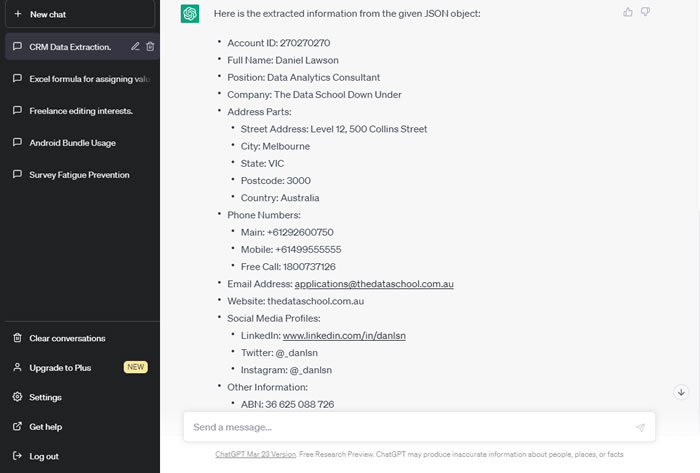
ChatGPT, for example, may uncover significant themes and insights from customer comments and reviews, social media posts, and other unstructured data sources. This is the best use of ChatGPT.
2. Generate SQL Queries
SQL is a popular programming language in technology that is vital for maintaining and manipulating relational databases. Writing SQL queries, on the other hand, can be time-consuming and challenging for those who are not experienced programmers. This is where ChatGPT comes in.
ChatGPT is a natural language interface that users may communicate with databases in simple language. This interface allows users to ask questions in plain English, and the associated SQL queries will be generated.
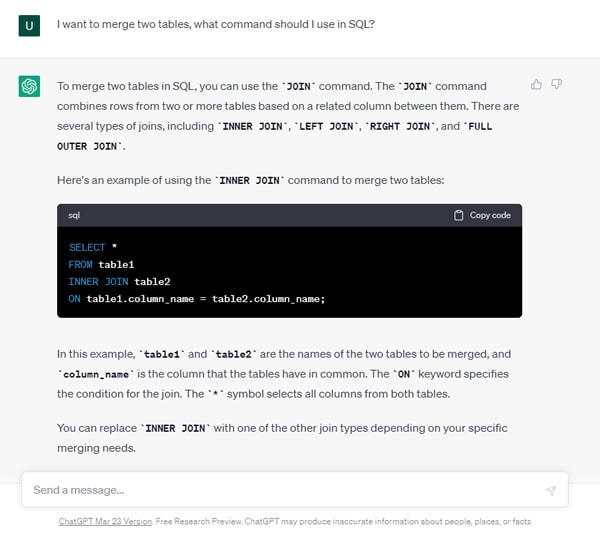
This functionality is beneficial for companies and organizations that do not have a dedicated IT department or a staff of expert programmers. Non-technical individuals may utilize ChatGPT to access and analyze their databases without specialized training or knowledge. ChatGPT helps to enhance data analysis and decision-making processes by simplifying the process of producing SQL queries, making it a crucial tool for enterprises and organizations of all sizes.
3. Customer Service
Customer service is integral to every organization since it dramatically influences client happiness and loyalty. ChatGPT can assist organizations in improving their customer service by delivering automated customer care.
Chatbots powered by ChatGPT can interpret natural language inquiries and offer valuable solutions to typical customer concerns and difficulties, lowering the pressure on human customer care agents and delivering faster and more efficient support to consumers.
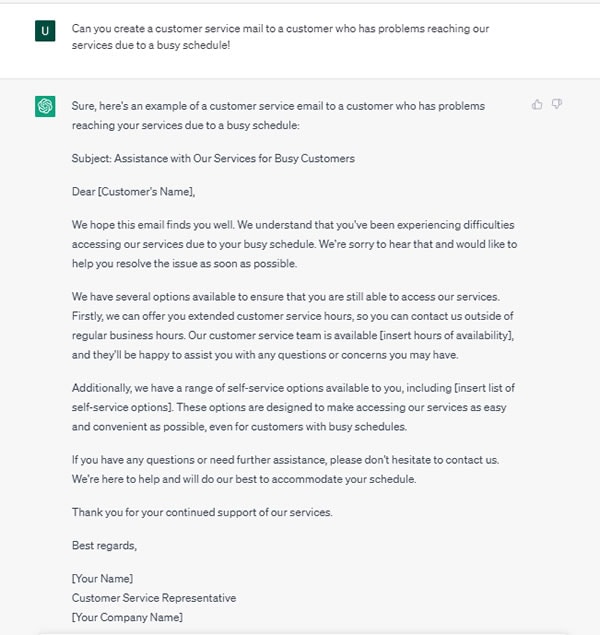
ChatGPT may also analyze client feedback and sentiment to discover common concerns and enhance customer service methods and products. Businesses may obtain insights into consumers' requirements and preferences by analyzing customer feedback and opinion and adjusting their offers appropriately. It can assist firms in increasing customer happiness and loyalty, resulting in increased revenue and growth.
4. Language Translation
ChatGPT's capacity to translate text between languages makes it a vital tool for worldwide enterprises and organizations. Companies may ensure that their message is correctly transmitted to audiences in different parts of the world by using ChatGPT for translation. It may assist organizations in reaching out to new clients, expanding their reach, and developing partnerships with individuals from various cultures.
Furthermore, ChatGPT's multilingual content development capabilities can assist enterprises in streamlining their content creation process. Rather than hiring many translators to manually translate information into different languages, ChatGPT can create translations automatically in a fraction of the time. Businesses may save time and money while still reaching a larger audience.

Furthermore, ChatGPT's understanding of the context and content of the material being translated can aid in ensuring that translations are correct and culturally acceptable. It is especially useful for companies that must communicate complicated thoughts or ideas that may not have a straightforward translation in another language. Even when standard rule-based translation systems fail, ChatGPT's NLP techniques may assist in ensuring that translations are nuanced and successful.
5. Generating Text
ChatGPT can create text for various applications such as content development, marketing, and social media. NLP approaches enable ChatGPT to comprehend the context and intent underlying the text being created, resulting in more natural and engaging content.
ChatGPT, for example, may produce product descriptions, social media postings, email newsletters, and other content. ChatGPT may also make material in various styles and tones, such as official, informal, or comical.
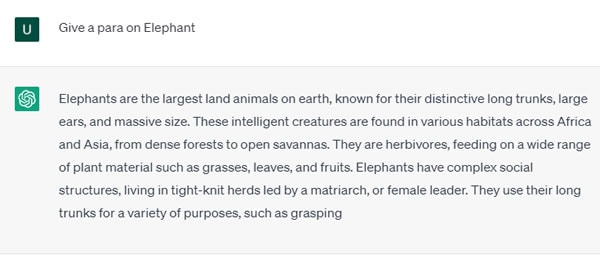
If you want to focus on creating video’s text, script and description, here is another powerful AI tool to help you with that. AI Copywriting tool by Filmora produces that depending on a subject or keywords. This function may be accessed by selecting the "AI Text" option in the editing panel. By creating high-quality written material that can be utilized to produce exciting video content, the AI Copywriting function may save video makers time and effort.
6. Content Personalisation
Personalization is becoming increasingly vital for organizations wanting to improve customer experience and engagement. ChatGPT can assist by analyzing user data and generating real-time personalized recommendations and messages.
An e-commerce site, for example, can utilize ChatGPT to analyze a user's purchasing history and browsing behavior to deliver personalized product suggestions. Similarly, a news website may utilize ChatGPT to analyze a user's reading history and offer personalized articles.
Businesses may give their users a more personalized and bespoke experience by employing ChatGPT for content customization, which can enhance engagement, satisfaction, and loyalty. It can also help firms better understand their consumers' needs and preferences, which can guide future product development and marketing initiatives.
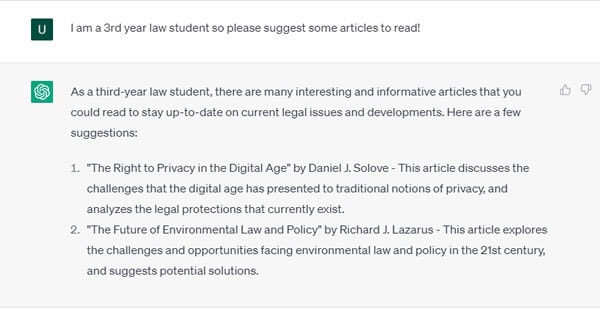
However, it is critical for businesses to be upfront with their consumers about how their data is being used and to respect data privacy standards to secure user information. Businesses may develop trust and confidence in their personalized content offerings by adopting appropriate protections and communicating clearly with users.
7. Assistance in Virtual Writing
The natural language processing capabilities of ChatGPT may assist authors in various ways. It might propose alternative phrasings or better word selections to enhance the written content's clarity and impact. ChatGPT may also help you spot grammar and spelling issues, making your work more polished and professional.
Furthermore, ChatGPT may assist authors in creating content by suggesting topic ideas, helping with research, and establishing the layout of the article. It can save authors time and effort, enabling them to concentrate on the creative parts of their work.
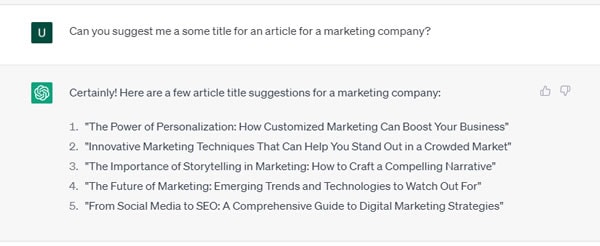
8. Generate Summaries
ChatGPT may summarize more extensive texts such as articles, reports, and research papers. NLP methods enable ChatGPT to comprehend the text's significant concepts and essential elements and summarize it simply and understandably.
For example, journalists may use ChatGPT to swiftly summarize breaking news articles, while scholars can use it for summarizing scholarly publications. Students may also use ChatGPT to summarize more extensive texts for study purposes and by professionals to absorb vital information swiftly.

9. Text Classifications
ChatGPT can categorize text into many groups depending on its content. NLP approaches enable ChatGPT to comprehend the meaning and context of the text, which may then be used to categorize it as subject, sentiment, or intent.
ChatGPT, for example, may be used to categorize customer comments as positive, negative, or neutral emotions or to categorize social media postings as news, entertainment, or sports. ChatGPT may also be used to organize text for data analysis or to organize information on websites or social media platforms.
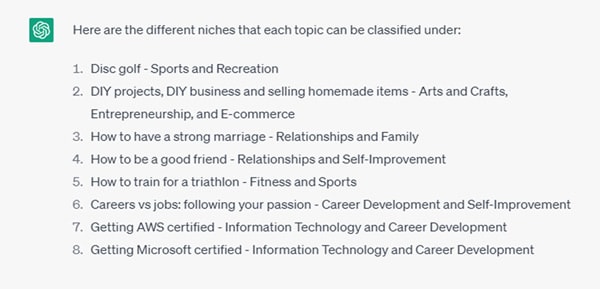
10. Sentiment Analysis
ChatGPT can analyze text data for sentiment to assess the emotional tone of the material. ChatGPT may employ NLP techniques to analyze the language used in the text and determine if the sentiment is good, harmful, or neutral.
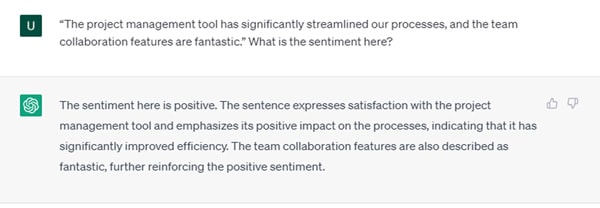
ChatGPT can, for example, be used to analyze consumer comments and reviews to discover common themes and sentiments or to analyze social media posts to detect patterns and emotions surrounding a specific topic or event. Businesses may utilize sentiment analysis to monitor their brand reputation, enhance customer service, and find opportunities for product improvement.
Conclusion
ChatGPT is a versatile tool that can be utilized for various tasks ranging from language translation to content development and personalized marketing. ChatGPT's superior NLP algorithms may assist organizations in streamlining operations, improving customer service, and extracting essential insights from unstructured data sources. ChatGPT is primed to become an even more helpful asset for organizations trying to remain ahead of the curve as technology improves.
FAQ
-
1. What distinguishes ChatGPT from other natural language processing (NLP) tools?
ChatGPT distinguishes itself from other NLP tools by its innovative design and vast training dataset. ChatGPT is built on the GPT-3.5 architecture, which allows for sophisticated language interpretation and creation. ChatGPT has also been trained on a vast dataset of over 45 terabytes, allowing it to interpret and create text in various settings and topics. -
2. How does ChatGPT secure user data security and privacy?
OpenAI, the ChatGPT developer, has solid standards and processes to safeguard user data security and privacy. To avoid unauthorized access, all data used to train ChatGPT is anonymized and stripped of identifiable information, and user data is stored securely and encrypted. Furthermore, OpenAI performs regular security assessments and collaborates closely with clients to guarantee compliance with all applicable data privacy legislation. -
3. Can ChatGPT be used in any industry?
ChatGPT may be utilized in various industries, from customer service and marketing to healthcare and banking. Its capacity to interpret and create natural language makes it helpful for any text-based communication application. ChatGPT, for example, may be used to automate customer service in e-commerce, produce personalized content for marketing campaigns, and aid with medical diagnostics in healthcare.



 100% Security Verified | No Subscription Required | No Malware
100% Security Verified | No Subscription Required | No Malware

